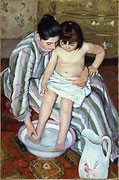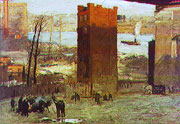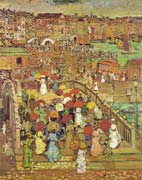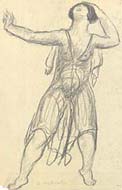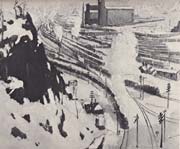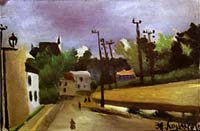recorded by Richard N. Miller
Another American, Mary Cassatt is coming now. Mary Cassatt had two paintings in the 1913 show of her favorite subject, mother and child. She only painted that, all her life, very much like this one called The Bath (Fig. 17), 1910. That was not in the Show, I don’t think it was in the 1913 Show. In France, where she spent most of her life, she was very closely associated with the Impressionists—Degas, Pissarro, Berthe Morisot—and considered one of theirs. This painting is owned by the French government in the Petit Palais collection in Paris. Now, we have the lights. Before we go on with the slides, I wanted to elaborate a bit on the art situation in America in the years before 1913. In New York, the private gallery of Alfred Stieglitz, Fifth Avenue, situated at 291 Fifth Avenue, although concerned with the establishment of photography as an art, was the scene of the introduction of Rodin, January 1908, and Matisse, April 1908, to America. I mean they didn’t come, only their things came, hmm (laughs). Stieglitz and Steichen, during the next years, followed up by showing Toulouse-Lautrec, Henri Rousseau, Cezanne, Picasso, and the American Max Weber. In 1910, the 291 Gallery gave a group show of American artists: Marsden Hartley, Dove, John Marin, Alfred Moore, Walkowitz, and others. Quite independently from 291, and more like a gesture of revolt against the Academy, a group of American artists held an exhibition in 1908 at the Macbeth Gallery in New York called The Eight Show. Robert Henri, John Sloan, George Luks, William Glackens, Ernest Lawson, Everett Shinn, Arthur B. Davies, and Maurice Prendergast. The show of The Eight at the Macbeth Gallery was a tremendous success, and was soon followed by the creation of a Henri School of Art, headquartered in the famous Lincoln Arcade Building, where lived myself later on, on 66th Street, where a large group of younger artists, like Bellows, Stuart Davis, Edward Hopper, Walter Pach, joined the ranks of the original Eight, under the guiding spirit of Robert Henri. The group was to be called, much later, the Ashcan School, which, to a certain extent, was a prophecy of what we know today as a proper art school, hmm? (laughter) In April 1910, a large independent show was organized by Sloan and Walt Kuhn. The great success of the show established firmly the faction of the young American artists in opposition to the Academy. Such was the climate in which Arthur B. Davies, elected president of the newly-formed Association of American Painters and Sculptors in 1912, conceived with Walt Kuhn and Walter Pach, the project of an expanded version of the 1910 Independent with the participation of European artists. The project materialized in the Armory Show of 1913. Among the difficulties to organizing this large exhibition, the first important obstacle was the duty imposed on all import of all fine arts to America at that time. It was a remarkable decision of John Quinn, the famous New York lawyer and art patron, to go to Washington, and argue and convince the lawmakers to change the law. He succeeded, and obtained the admission duty-free of all fine original works of art to America less than a hundred years old, I believe. This action is still enforced today. Now, we will see more, more, more slides. Yes. This is Henri. Robert Henri. Robert Henri was really a moving spirit of American modern art, in the period immediately preceding the Armory Show, though he was a finer teacher than a painter, in my opinion. This painting called Laughing Boy (Fig. 18) was not in the original show, but in the show of The Eight I spoke of, in 1908. It is a typical Henri portrait, but still too academic, I feel. The Ashcan is [inaudible]. (laughter) Bellows. George Bellows, one of Henri’s pupils, belongs to the generation of the Ashcan School, and he is known for his pictures of boxing matches, executed in a dynamic narrative style. This view of Lower Manhattan called The Lone Tenement (Fig. 19) was painted in 1909, after Bellows had been accepted by the Academy in 1907, and before he began painting sports scenes of violent realism, which is more the Ashcan, like boxing. Prendergast. A beutiful Prendergast. Maurice Prendergast spent his formative years in Europe. When he returned to America, he was invited to join the exhibition of the Eight in 1908 with Arthur B. Davies, Ernest Lawson, and the Henri group. He also showed at the Independents, 1910. Later on, Prendergast, Glackens, Bellows, and Charles Sheeler were among the founders of the second Society of Independent Artists – no jury - in 1917 in New York. This painting, called Ponte della Paglia (Fig. 20), was probably painted in Italy in 1899, I think. The flag is green. It’s an Italian flag in 1899. It shows, perhaps, an influence of Bonnard. It’s very true for the one in the anniversary show, upstairs, in the collection of this institute, Landscape with Figures. I remember, Prendergast was a very nice person. Very…very…almost timid. Now, Walkowitz. Walkowitz is 82 now, today—82 years old today. He was born in Siberia, and came to the United States as a child. The title of these three drawings is Duncan Dancers (Fig. 21). Walkowitz made a great number of studies and drawings in the Isadora Duncan School of Dance. His sketches of Isadora and her pupils are a very vivid evocation of the great American dancer and teacher. At the time of the Armory Show, he was with the Stieglitz group. Katherine Dreier. Katherine Dreier sent this oil, The Blue Bowl, and we never could find it. It is certainly not lost, but we couldn’t find it. At the Armory Show, she had spent several years in Europe, and brought back a small collection of European artists, among which is van Gogh’s Mademoiselle Ravoux, that you saw on the screen a moment ago. As a pioneer of abstract art, she established a few years later the Société Anonyme and The Museum of Modern Art of 1920, long before the other Museum of Modern Art. A collection of international artworks, which is now at Yale University. Kroll. Leon Kroll. You can hardly see it, it’s from a newspaper, but anyway. He painted this painting called Terminal Yards (Fig. 22) around 1911, and it was in the 1913 Show. Unfortunately, I have been unable to find a better slide. This one is taken from a newspaper reproduction. The painting was bought at the Armory Show by Arthur Jerome Eddy, a Chicago lawyer and art collector, a rather eccentric character - he bought two of my own paintings, (laughter) and was the first man in Chicago to have his portrait painted by Whistler and to ride a bicycle (laughter). You know, I knew him and he was very nice man. Rousseau. Rousseau, Rousseau, Rousseau. Le Douanier has three landscapes in the present show, very much in the spirit of this one, which is called View at Malakoff (Fig. 23). Malakoff is a small town on the outskirts of Paris, dated 1898. I think it was also in the original Show, and I want to show you a bigger one, which was not in the Show. And now, in another vein, which accounts for his fully-deserved recognition, Rousseau becomes the dreamer, the poet in these large paintings like this one, called The Dream, painted in 1901. >> Next
|
